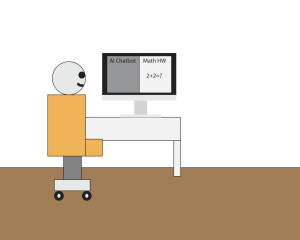The power of coding: junior produces apps
COMMANDING CODE: Zach is working through codes on the computer. He’s refining his third app, Finished, ready to be complete by winter break.
October 21, 2019
The breeze carried chlorine from the pool, soft waves lapping at the shallow end, enticing anyone to step in for a swim. But he was too preoccupied with his computer, the sound of a keyboard as steady as the beat of his heart. The previous summer, it was adding data to his second app, Swim Stats. This time around is the app Finished, a homework organization app that would render planners unnecessary.
Junior Zachary Eilers has produced two apps, Meteor Storm and Swim Stats, which are meant to be both informal and entertaining for students. He began developing apps in his sophomore year when he found a Google coding app called Flutter.
Eilers’ interest in mobile apps was sparked from the way that our world is transformed from mobile apps and that led him to pursue coding.
“I taught myself to code in eighth grade, and the first thing I did was [build] an Android app using a program called MIT App Inventor,” Eilers said. “You can drag these code blocks to form the logic of your app.”
Later, in his freshman year, Eilers finished the Java coursework for Computer Science in November. From then on, he dedicated the class to developing his coding skills.
“One great place to look is a site called Udemy. It’s an Online course marketplace,” Eilers said. “The courses are taught through video and so you code along with the instructor, and you learn from how they’re doing everything,”
Eilers began to develop his first app for iOS after learning how to code and use variables.
“[I] get a rough sketch of what each screen’s gonna look like and how the user interface is gonna work,” Eilers said. “[Then,] I will build out the screen, build out features… [and] once I have all the bugs fixed, and I feel that it’s ready, I’ll release it.”
This is how Eilers created his first app, Meteor Storm. It was all programmed with CoronaLabs.com.
“The Earth is in the center of the screen, and there [are] meteors that fly from the edges toward the Earth. You have to tap them too before they get the Earth to blow up,” Eilers said. “After a certain number of meteors hits the Earth, [it] blows up and you lose the game. Your score is the number of meteors that you destroy before the Earth explodes.”
After launching Meteor Storm, Eilers discovered Google Flutter, a coding framework that determines the general look, shape, and location of any coded items.
“A framework is code that framework authors have written [and] designed to take care of… interacting with the phone,” Eilers said. “The way a game works on a phone is by calculating frame by frame what the screen is going to look like, and then putting it on the screen. I don’t have to worry about that because I use a framework that figures it out for me.”
The easy format of Google Flutter allows Eilers to focus on the idea and design of his apps.
“I really like the material design components within Flutter,” Eilers said. “I [can] plan out the application a little bit more because it [makes] developing the app take much less time.”
His second app, Swim Stats, is able to generate detailed information on the different swim trials, times, and bios on swimmers all across the states using his custom-made server on Amazon Cloud. It’s Eilers’ first app created by Google Flutter.
“The server gets the requests, takes the name from it, and plugs it into a form on the U.S.A. Swim Website to essentially search for the times of that summer,” Eilers said. “[Then it] takes the HTML page…grabs the little pieces of data from it, and then returns it back to you.
Eilers formatted his app so any saved swimmer’s name and information will be instantly accessible, even without an Internet connection.
“Currently, you can search ‘U.S.A. Swimming Time,’ go on their website, and search for a time. However, it’s a little bit tedious [if] there’s no Internet connection,” Eilers said. “One of the features of my app is when you search for a swimmer, all the data from that swimmer is automatically saved. You can quickly and easily view [their] saved times… so you don’t have to go [and] search [for] them again.”
He’s working on his new app, Finished, this year.
“It will help [students] organize their schedules,” Eilers said. “[This way,] they’re not cramming and staying up until 2 a.m. the night before something is due.”
Eilers doesn’t have any way to handle user feedback through the apps. He said the suggestions for improvements come from his friends.
“I might put my email in the app and the settings page,” Eilers said. “[I can] create a form the user can fill out to provide feedback on the app.”
Zachary’s close friend, junior Wes Wasserburger, is someone who provides feedback as much as possible. He enjoys the features of the Swim Stats app, as it enables him to keep track of any swimmer’s times.
“I like [the] effort that he put into the looks of his app,” Wasserburger said. “It’s worth downloading because it’s a really solid app and there’s no product out there quite like it.”
Zachary’s father, Bradley Eilers, has worked in several roles related to computers, some of which are software development, enterprise architecture, and IT management. He got a Computer Engineering degree from Texas A&M and has worked with Zach on his apps, encouraging Zach to move forward with his skills.
“From the time Zachary took Mr. Howard’s game design class at Gorzycki, he started asking me tons of questions about how the Internet works,” Bradley said. “I really enjoyed those discussions and they eventually led to us working together to create a simple website related to swimming. Zachary decided he could create a better user experience as a mobile app.”
Nearly every industry has been disrupted by technology, as Bradley puts it. He believes his son’s accomplishments are important for the future of his career choices.
“Amazon has changed Retail. Uber disrupted the taxicab industry. The list goes on,” Bradley said. “The point is that coding and technical skills will be critical no matter what industry you are in. Not every one of the current generation of students needs to be a hardcore coder, but they do need to understand how technology works to compete in the job market of the future.”











